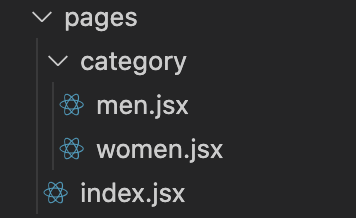Question:
How can we setup routes in Next.js? If I need two pages with urls / and about in Next.js, what should we do?
Answer:
In Next.js, we just have to follow its convention. Create a pages folder in the root and create two files inside it. The file names should be index.js and about.js. It can be .jsx files also. The url path is decided by the file name. index.js maps to / path.
Question:
I am working on a Next.js project. The pages folder structure looks like this:

What will be the urls generated based on this folder structure?
Answer:
Three urls will be created.
/
/category/men
/category/womenQuestion:
If I have 2 files that resolve to same url, what will happen in Next.js? For example, what will happen when we run a Next.js project with following pages folder structure?

Answer:
Here when we try to take /category url, it will render the page from pages/category.jsx. But Next.js warns the developer in the console, saying:
Duplicate page detected. pages/category.jsx and pages/category/index.jsx both resolve to /category.Question:
How to handle dynamic routes in Next.js? For example: In my ecommerce site, the category page has dynamic routes. /category/men lists all products under men. /category/shoes lists all products under shoes. So the category name which comes after /category/ is dynamic. How should we design the pages folder structure to handle this request?
Answer:
First create a folder category under pages folder. Then create a file named [category].jsx inside category folder. Inside the square brackets we can use any valid identifier. This identifier is later used to extract the value of dynamic route.
Next we define a component in [category].jsx.
import React from "react";
import { useRouter } from "next/router";
function Category() {
const router = useRouter();
const { category } = router.query;
return <div>{category}</div>;
}
export default Category;Here we defined a functional component. That is why we used useRouter hook from next/router. We create a router object and later extract the category value from router.query.
Question:
If I name a file under pages folder as [...params].jsx, what does that mean?
Answer:
It means, you just created a catch-all route. If [...params].jsx is present under pages/products folder, then all unhandled urls starting with /products end up in [...params].jsx.
In the jsx file, we can extract the url path from params property.
